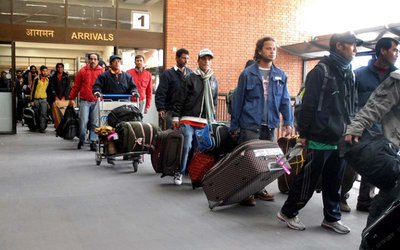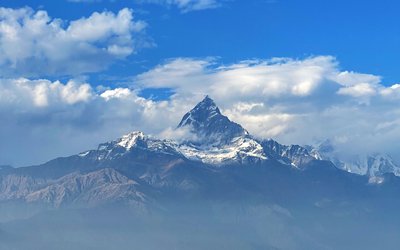I usually write on regional economic issues but this time I want to go off topic and talk about secularism—a political idea that is coming under attack in India as well as in Nepal. I want to posit the argument that the high-pitch resurgence of anti-secular politics in India and the low-pitch grunts one hears from centre-right parties in Nepal are actually linked. Unfortunately, while India is perhaps just sneezing, Nepal can develop a full-blown influenza just because of how politics operates around this neighbourhood.
What ails India today is its economy not secularism. The out of wit Modi government professes to see “green shoots” in the economy just because third quarter GDP figures rose 0.2 percent compared to the 4.5 percent figure from the second quarter. The reality is something else. Banks are bag-holding bad debts, government is trying to boost the economy with a deficit budget and worried about inflation at the same time, revenue receipts are low, rural consumption is falling and urban unemployment among youth has touched disheartening levels. The Modi-Shah duo realizes that they don’t have very many rabbits left in the hat and so it is time to pull out the Hindu-Muslim card. They know that communal politics yields results in India and when the divisive discourse can be garbed as a principled opposition to secularism you don’t have to feel dirty either.
But India has a particular history around which the BJP bases its calculations. Almost 90 years ago in pre-independence India, the question as to whether India is a country for all Hindustanis or just for Hindus was being debated in elite Hindu circles. Not very different from this strand of thought was the question of whether Muslims in India require a homeland of their own. This “two nation theory” has lived through its evolution, managed to create a new country called Pakistan and, with a rare streak of wisdom and perhaps luck, managed to turn what was left of Hindustan into today’s secular India. Up until the 1990s, this was a politically settled arrangement and there was no reason to disrupt a system that more or less worked.
Then comes BJP in the scene, figures that inciting majoritarian sentiments is good electoral politics, demolishes a mosque, plays dubious roles in the riots that follow, and seals the deal with India’s agitated Hindus by orchestrating the Gujarat Riot of 2002, while the party was in power in that state as well as at the centre. Fast forward to 2019-20, BJP is in-charge again, the economy is in the doldrums, and in comes the Citizenship Amendment Act which selectively offers citizenship to all other sub-continental religions except Islam. Then follows an incendiary political campaign during Delhi state elections, persistent spewing of hate speech becomes common in rallies around Delhi and, finally, the Delhi riots of February 2020, which kills four dozen people, mostly Muslims. The project is now almost complete, Muslims in India have begun to harbour deep insecurity and a sense of alienation and the majority Hindu population feels it has reasons to fear the Muslims instead. At a strategic level, this outcome is all that BJP wants to see with its anti-secular politics.
What then are the right-wing parties in Nepal, including the new center-right entrant to the bandwagon--Sajha Party--hoping to achieve in Nepal by challenging secularism? If politics of the masses mattered, while secularism in Nepal may not be a home-grown idea and as an idea Nepalis may not have struggled with it as much as Indians have, it hasn’t hurt anyone in Nepal. It has made Nepal’s religious minorities feel more belonged. We are learning to keep our religion in the sanctity of our souls rather than out in the public square and we have begun to question why a state should have a religion. To the Nepali state, secularism is more of a principle than policy; it doesn’t spend too much time thinking about it. The Hindu majority in Nepal has nothing fear from other religions, its identity has no known threats, and keeping religion away from the state hasn’t put any citizen at a disadvantage. What then is the reason to contest secularism in Nepal? Are Nepali political parties mixing up the contexts and attempting to try BJP’s “best practices” in Nepal?
Ordinary Nepalis don’t follow Indian politics, don’t read Indian history, and inter-faith animosity is not a lived experience for many Nepalis. The political class in Nepal, on the other hand, looks South for political ideas, copies electoral tactics from across the border, hobnobs with Indian politicians, and routinely devours the low-quality journalism coming out of Indian television channels. It is probably this “soft power” and some tacit cross-border alliances that are coming together to contest secularism in Nepal. We have to be mindful though India’s secularism has much deeper roots and will not go away easily. In Nepal, all kinds of thoughtless political ideas can gain currency and this gradual build-up of anti-secular political noise just might do away with Nepal’s chance to constitutionally assure its religious minorities that the state doesn’t have anything against them.

Sagar Prasai
Prasai is a freelance consultant based in Kathmandu. He frequently writes on water and energy issue for regional and international outlets
- Covid-19 In Nepal: Where Are We After 9 Weeks Of Lockdown?
- May 19, 2020
- C-19 Response In Nepal: Incompetence Was Expected But The Apathy Towards The Poor Is Astounding
- Apr 15, 2020
- The Indian Slowdown Could Dampen Nepal’s Electricity Export prospects Further
- Jan 03, 2020
- For smaller Countries In South Asia, intensifying India-China Competition In South Asia Is Becoming A Headache
- Nov 13, 2019
- Sambridhi By Doing Nothing: The Free Lunch Is About To End
- Sep 08, 2019












